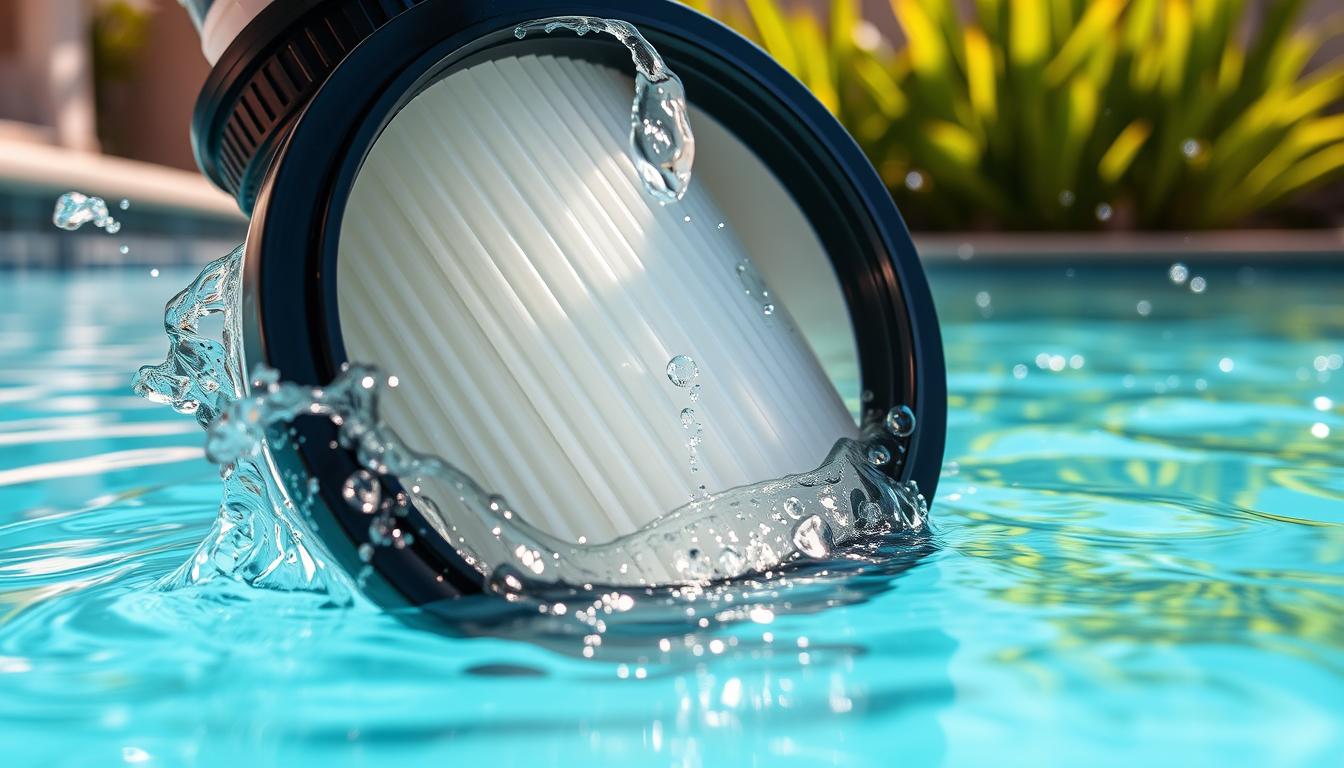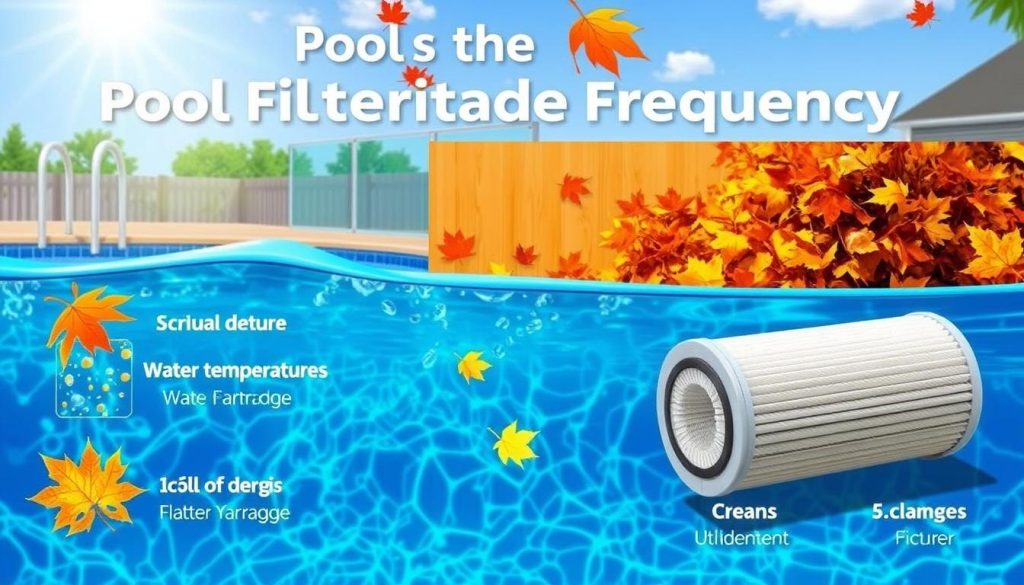
Clean, clear pools are every owner’s dream. Regular filter cartridge cleaning is key to maintaining water quality. Let’s explore how often you should clean your pool filter cartridges for the best results.
Picture this: It’s a scorching day, and you’re ready to dive in. But wait! The water looks cloudy and uninviting. Your neglected filter cartridge is to blame.
Don’t let this happen to you! Proper cleaning keeps your pool sparkling all season long. Let’s learn how to maintain your filter cartridges effectively.
We’ll explore factors affecting cleaning frequency and share expert tips. You’ll learn to spot signs that it’s time to clean. We’ll also help you create a maintenance schedule that fits your pool.
Get ready to dive into the world of filter cartridge care. With our guidance, you’ll enjoy crystal-clear water all summer long.
Understanding Pool Filter Cartridge Maintenance
Clean pool water relies on proper filter care. Regular cleaning and replacement of cartridge filters prevent clogs and reduce water loss. Your pool will stay clean and inviting for your family.
Why Regular Cleaning is Essential
Cartridge filters trap debris, dirt, and contaminants in your pool water. As they collect particles, filters become clogged, reducing efficiency and straining your pool pump. Regular cleaning maintains filter performance and prevents issues.
Clogged filters can lead to cloudy water and bacterial growth. They also increase pressure on the pool pump, causing overheating and early failure. Clean your cartridge filter every six months for crystal clear water.
- Cloudy or hazy water due to reduced filtration effectiveness
- Potential bacterial and algal growth in the accumulated organic matter
- Increased pressure on the pool pump, leading to overheating and premature failure
Signs Your Cartridge Needs Cleaning
Recognize when your cartridge filter needs cleaning to maintain clear pool water. Watch for these signs:
- Significant rise in filter pressure, typically an increase of at least 8 PSI above the normal operating level
- Reduced water flow, resulting in less effective circulation and filtration
- Cloudy or hazy pool water, despite regular chemical treatments
On average, cartridge filters should be cleaned every six months and replaced at least every two years to maintain optimal performance and extend the lifespan of your pool equipment.
| Filter Type | Cleaning Frequency | Replacement Frequency |
|---|---|---|
| Cartridge | Every 6 months | Every 2 years |
| Sand | Backwash when pressure rises 7-10 PSI | Every 5-7 years |
| Diatomaceous Earth (DE) | Backwash when pressure rises 7-10 PSI; Full teardown annually | Every 2-3 years |
Stay proactive with your pool filter maintenance. Follow these guidelines to enjoy a clean pool all season. You’ll also extend the life of your pool equipment.
Factors Affecting Cartridge Cleaning Frequency
Pool filter cartridges need regular cleaning for optimal filtration. How often depends on various factors. Understanding these can help you create an effective cleaning schedule.

Pool Usage and Bather Load
The number of swimmers affects how often you clean filter cartridges. More swimmers mean more contaminants in the water. This can quickly clog filters.
Busy pools may need new cartridges every 6 months. Less used pools can go 18-24 months between replacements.
High-usage pools may require filter cartridge replacements every 6 months, while moderate-usage pools typically need replacements every 9-12 months. Low-usage pools may only require cartridge replacements every 18-24 months.
Environmental Conditions and Debris
Your pool’s surroundings impact cleaning frequency. Trees and plants nearby can lead to more debris. This can clog filters faster, reducing their efficiency.
Dust, wind, and extreme weather also add contaminants to pool water. Pools in dusty or windy areas may need more frequent filter cleaning.
Water Chemistry and Balancing
Proper water chemistry is crucial for your pool and filtration system. Unbalanced water can cause mineral buildup and decrease filter performance.
- Regularly test and adjust your pool water’s pH, alkalinity, and calcium hardness levels to prevent the buildup of contaminants that can clog filter cartridges.
- Ensure proper chlorine or sanitizer levels to prevent the growth of algae and bacteria, which can also contribute to filter cartridge fouling.
- Monitor and control the levels of oils, lotions, and sunscreen residues in your pool water, as these substances can quickly accumulate on filter cartridges and reduce their filtration efficiency.
| Water Chemistry Parameter | Ideal Range | Effect on Filter Cartridges |
|---|---|---|
| pH | 7.2-7.6 | Unbalanced pH can lead to mineral buildup and decreased filter efficiency |
| Alkalinity | 80-120 ppm | Low alkalinity can cause rapid pH fluctuations, affecting filter performance |
| Calcium Hardness | 200-400 ppm | High calcium levels can cause scale formation on filter cartridges |
| Chlorine | 1-3 ppm | Insufficient chlorine can allow algae and bacteria growth, clogging filters |
Addressing these factors can optimize your pool’s filtration system. This extends equipment lifespan and ensures a clean, healthy swimming environment.
How Often Should You Clean Pool Filter Cartridges?
Clean pool filter cartridges are crucial for crystal-clear water. Let’s explore how often to clean them. We’ll look at general guidelines, pressure gauge readings, and adjusting your cleaning schedule.
General Recommendations for Cartridge Cleaning
Most residential pools with one filter cartridge need cleaning every 30 days. This prevents clogging of the filter media. Larger quad-cartridge filters can go up to 4 months between cleanings.
Filter cartridges typically last about three years before replacement. Frequent cleanings, visible wear, high pressure, and age can shorten their lifespan.
Monitoring Pressure Gauge Readings
The pressure gauge reading shows when your filter cartridge needs cleaning. For swimming pools, clean when pressure reaches 25% above the starting pressure. This increase means the filter is clogging up.
| Pool Type | Cleaning Trigger |
|---|---|
| Residential (single cartridge) | Every 30 days |
| Residential (quad-cartridge) | Every 4 months* |
| Swimming pools | 25% above starting pressure |
*Depending on pressure gauge readings and filter condition.
Adjusting Cleaning Schedule as Needed
Customize your cleaning schedule based on your pool’s unique needs. Pool usage, environment, and water chemistry affect how often you clean filters.
- Heavy pool usage may require more frequent cleanings
- Nearby trees or dust can clog filters faster
- Imbalanced water chemistry can cause mineral buildup
Spa owners are recommended to establish a routine cartridge cleaning schedule based on the amount of spa usage.
Monitor your pool’s conditions and pressure gauge readings regularly. This helps you adjust your cleaning schedule for optimal filtration. It also extends the life of your filter cartridges.
Best Practices for Cartridge Filter Maintenance
Proper pool cartridge cleaning is vital for optimal performance. Start by turning off the pump and relieving system pressure. Remove the cartridge carefully, noting its orientation for reinstallation.
Rinse the cartridge thoroughly with a garden hose and spray attachment. Focus on removing stubborn debris. Inspect the cartridge for signs of wear or damage.
For deep cleaning, soak the cartridge in a specialized solution. This removes oils and tough contaminants. Let the cartridge dry completely before reinstalling it.
Restart your filter system and check for leaks. Ensure the pressure returns to its normal range. Cartridges typically last about 2,000 hours or 1-2 years.
Watch for signs that it’s time to replace your cartridge. These include more frequent cleanings and visible wear. High pressure readings or reaching the end of its lifespan are also indicators.
Regular filter care keeps pool water clear and extends filtration component life. Clean cartridges every 1-3 months, depending on usage and environment. This prevents buildup and ensures optimal filtration.
Inspect your filtration system after each maintenance session or annually. This helps identify potential issues before they become serious problems. Prioritize proper maintenance for a sparkling clean pool.







